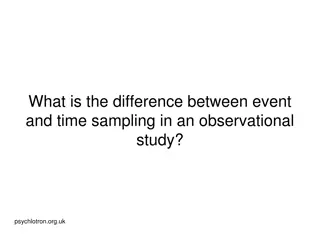Exploring Key Characteristics of Qualitative Research in Psychology
The lecture series delves into the values, characteristics, and theoretical foundations of qualitative research, emphasizing the differences from quantitative methods. It explores experiential and critical qualitative camps, subjectivity, reflexivity, and ontological and epistemological foundations. The growth of qualitative research in psychology is noted, despite challenges of exclusion from prestigious outlets. The emergence of a qualitative research paradigm in psychology is also discussed.
Download Presentation

Please find below an Image/Link to download the presentation.
The content on the website is provided AS IS for your information and personal use only. It may not be sold, licensed, or shared on other websites without obtaining consent from the author. Download presentation by click this link. If you encounter any issues during the download, it is possible that the publisher has removed the file from their server.
E N D
Presentation Transcript
Foundations of Qualitative Research 2 Part 1: Key characteristics of qualitative research Presentation by Victoria Clarke Associate Professor of Qualitative and Critical Psychology, UWE August 2021
PowerPoint slides from the Braun, Clarke & Hayfield Qualitative Methods Online Teaching & Learning Resources Collaboration (QMOTLRC) Image of a white woman - Virginia Braun - a head and shoulders shot, she is wearing a red and white striped long sleeved top and glasses, and has her hands resting on either side of her face
Topic overview o This is the second of two lectures each divided into three parts - exploring the values, characteristics, and theoretical and philosophical foundations of qualitative research. o The aim of this second lecture is to provide further grounding in the foundations of qualitative research - introducing some of the concepts and terminology that define qualitative research. o This lecture explores some of defining characteristics of qualitative research and how qualitative research differs from quantitative research. o This lecture also builds on the discussion of different orientations to qualitative research in the first lecture by considering experiential and critical qualitative camps . o Finally this lecture explores the key concepts of subjectivity and reflexivity and the ontological and epistemological foundations of qualitative research. o There are some opportunities to pause the recording and reflect on your knowledge and understanding of qualitative research.
Lecture overview oPart 1: Key characteristics of qualitative research oPart 2: Experiential and critical qualitive research oPart 3: Key (theoretical and philosophical) concepts in qualitative research
The growth in qualitative research (in psychology) the growth in qualitative research in recent years... has been phenomenal. Although the volume of qualitative research in psychology relative to quantitative methods remains modest, and despite the exclusion of qualitative research from many of the most prestigious outlets, qualitative articles are being published increasingly in mainstream psychology journals. As well, there has been an explosion in dedicated textbooks, journals, conferences, and workshops attempting to address the demand for qualitative research from students, researchers, practitioners, and policy makers. (Madill & Gough, 2008: 254)
The emergence of a qualitative research paradigm the example of psychology Qualitative ideas and approaches have been part of psychology from its inception. However, quantitative methods employed within a (post)positivist, experimental paradigm have dominated the discipline. The more subjective, interpretative introspective (qualitative) techniques of early psychology became classified as unscientific . It wasn t until the 1980s that qualitative approaches regained a foothold, and subsequently flourished, in some areas of psychology. Their (re)appearance reflected the development of a number of oppositional approaches within the social sciences, which challenged mainstream (post)positivist empiricist research design and practice. It s important to understand that qualitative research is not simply a complementary approach to quantitative research.
Pause for reflection 1 If you have listened to Foundations of Qualitative Research 1, pause the recording and make a note of your understanding of the definitions of Small q qualitative. Big Q qualitative.
Big Q and small Q qualitative research The most basic definition of qualitative research is that it uses words as data, collected and analysed in all sorts of ways. As we explored in Foundations of Qualitative Research 1, the term qualitative research is used to refer both to techniques (of data collection or data analysis) and to a wider framework of values for conducting research, or a paradigm. Big Q qualitative research is not just about data and techniques but the application of qualitative techniques within a qualitative paradigm (Kidder & Fine, 1987). Small q qualitative research is the use of specific qualitative data collection and techniques, with a quantitative or (post)positivist framework.
Qualitative research as a paradigm - characteristics An assumption that there is no one correct version of reality; there are multiple versions of reality (even for one person) and these are closely linked to the context they occur in. The use of qualitative data, and the analysis of words which are not reducible to numbers. The use of more naturally occurring data collection methods, that more closely resemble real life this develops from the idea that we cannot make sense of data in isolation from context. An interest in meanings rather than reports and measures of behaviour or internal cognitions.
Qualitative research as a paradigm continued The use of inductive, theory-generating research. A rejection of the natural sciences as a model of research, including the rejection of the idea of the objective (unbiased) scientist. The recognition that researchers bring their subjectivity into the research process; this is seen as a strength rather than a weakness. See Silverman (2000)
What is qualitative research all about? We should avoid seeing qualitative research as a homogeneous category (Henwood & Pidgeon, 1994: 226). Exploring meaning, rather than (abstract) universal laws of cause and effect. The complexities of meaning in context (multiple interpretations and meanings); rich or thick descriptions and interpretations of meaning and experience. Interdependence of individual and social/cultural systems of meaning. Language allows access to the richness of meaning and experience for people and allows a far deeper understanding of a phenomenon than using numbers (e.g. giving voice ). Some qualitative approaches have an interest in language practice the way various objects are represented and the ways language as a social practice is used to create particular versions of reality.
Pause for reflection 2 If you have listened to Foundations of Qualitative Research 1, pause the recording and make a note of your understanding of the definitions of A reflective view of language. An active, performative view of language.
Theories of language Influential British cultural theorist Stuart Hall s (1997) demarcated three different theories of representation we have translated this to capture different conceptualisations of language: Reflective: language reflects true nature of something it s like a mirror, it reflects back to us the truth of things. Reflective conceptualisations of language are realist; a material reality Independent of language - mind- independent truth - is assumed to exist, and be revealed through language.
Intentional and constructionist theories of language Intentional:language is used to convey the speaker s unique perspective on things, their reality. We see things uniquely; we use language to convey our truths. Intentional conceptualisations of language move away from universal meanings and locate meaning within the person (the mind- dependent truth). Constructionistconceptualisations treats language as social and meaning as more malleable and flexible. Meaning is created or constructed in and through language, and in and through language use, the ways we talk and write about things. Language here is understood as symbolic, and powerful, rather than neutral; as active, rather than passive.
Why do qualitative research? Some researchers choose qualitative research because it fits with their ontological and epistemological commitments more on O&E stuff or the ologies in Part 3. Some researchers choose qualitative research because of political commitments (in particular a commitment to social justice): Giving voice to socially marginalised groups. Deconstructing socially dominant sense-making. Some researchers choose qualitative research because they have questions about subjective sense-making and experiences or are exploring an under/unresearched area: Qualitative research is generally more participant led more potential for unanticipated insights, for understanding participants world-views and language, for reaching the parts quantitative methods cannot reach .
Comparing quantitative and qualitative research (Tolich & Davidson, 2003) Quantitative Numbers as data. Seeks relationships between variables, to explain or predict, with the aim of generalising the findings. Generates shallow but broad data. Seeks consensus, norms or general patterns. Tends to be theory- testing and deductive. Tends to be theory generating and inductive (working up from the data). Qualitative Words as data. Seeks to understand and interpret; recognises data as gathered in a context. Generates narrow but rich data (depth about a specific issue thick descriptions ). Seeks patterns, but accommodates and explores difference and divergence; good for working with contradictory data.
Comparing quantitative and qualitative continued Quantitative Qualitative Values detachment and impartiality (objectivity). Has a fixed design and method (harder to change focus once data collection has begun). Can be completed quickly. Large numbers of participants needed (for statistical power). Values personal involvements and partiality (subjectivity). Design and method are less fixed (can accommodate a shift in focus). Tends to take longer to complete. Smaller numbers of participants expected.
References for part 1 Hall, S. (1997). Representation: Cultural representations and signifying practices. Sage. Henwood, K., & Pidgeon, N. (1994). Beyond the qualitative paradigm: Introducing diversity within qualitative psychology. Journal of Community and Applied Social Psychology, 4, 225-238. Kidder, L. H., & Fine, M. (1987). Qualitative and quantitative methods: when stories converge. In M. M. Mark & L. Shotland (Eds.), New directions in program evaluation (pp. 57-75). Jossey- Bass. Madill, A., & Gough, B. (2008). Qualitative research and its place in psychological science. Psychological Methods, 13(3), 254-271. Tolich, M., & Davidson, C. (2003). Collecting the data. In C. Davidson & M. Tolich (Eds.), Social science research in New Zealand, 2nd ed. (pp. 121-153). Pearson Education.























